Quique Setién’s first game in charge of Barcelona ended in a 1-0 La Liga victory over Granada, an always tricky opponent to face who even managed to get the Catalans’ scalp before. But with the arrival of the new coach, we’ve also seen a somewhat rejuvenated Blaugrana that dominated the proceedings but still had trouble breaking down the opposition’s block.
But everything is easier with Lionel Messi and with a late strike following a red card from Granada, Barcelona managed to snatch all three points at the Camp Nou.
This tactical analysis will dissect both teams’ tactics and give you an in-depth analysis of Setién’s first game at his new club that propelled Blaugrana back above Real Madrid in the standings.
Lineups
Hampered by injuries to Ousmane Dembélé and Luis Suárez and a suspension to Frenkie de Jong, Setién’s hand was somewhat forced when it came to the lineup selection. Ivan Rakitić and Arturo Vidal started alongside Sergio Busquets as both Arthur Melo and Riqui Puig were on the bench and Samuel Umtiti displaced Clement Lenglet at the back.
Ansu Fati got a start next to Messi and Antoine Griezmann up front. This game also saw the return of Marc-André ter Stegen into the lineup. Barcelona were deployed in a 4-3-3 system on paper but this saw them shift to other formations throughout the match, as this tactical analysis will explain further down the line.
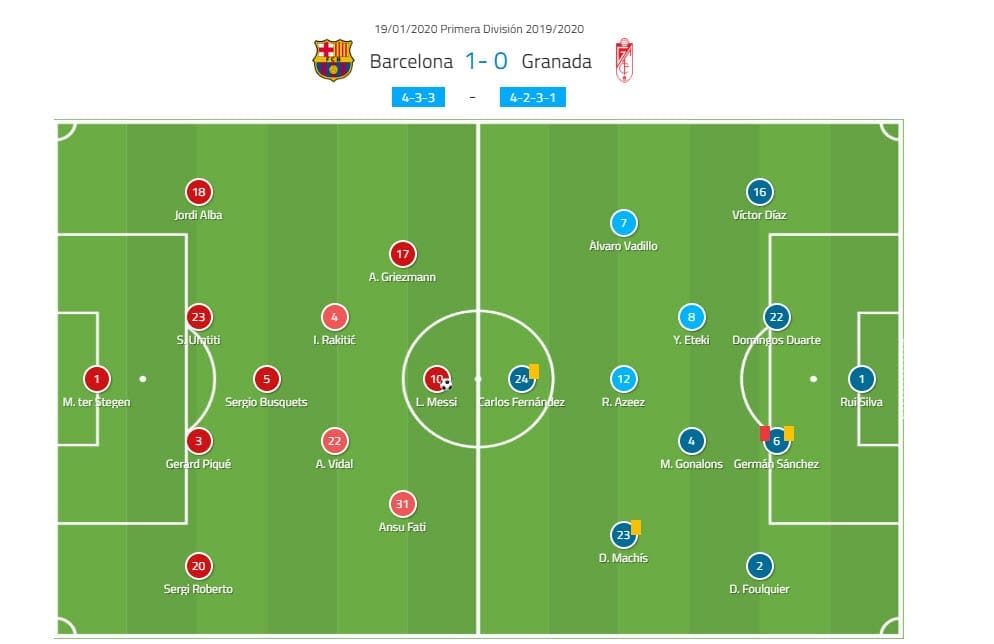
As for Granada, Diego Martínez also had to wrestle with some injuries and suspensions, resulting in a slightly altered lineup from the one he produced against Mallorca in their 1-0 triumph. Ángel Montoro was out with a yellow card suspension while the likes of Neyder Lozano, Quini and Fede Vico are still nursing different kinds of injuries.
Subsequently, a 4-2-3-1 formation saw Dimitri Foulquier return to the lineup in the backline and Maxime Gonalons replacing the suspended Montoro. Ramon Azeez was deployed just behind Carlos Fernández and flanked by Darwin Machís and Álvaro Vadillo.
Granada’s resolute approach
From the get-go, it seemed that Granada had a single plan for their approach and that was to weather the storm and maintain their compact block so as to frustrate Barcelona and negate any clear chance creation. To an extent, these tactics worked but ultimately failed to yield them a favourable result.
For the vast majority of the game, Granada were turtled up in their own half, deploying a low-to-mid narrow block that aimed to suffocate space in the middle channels. Their formation and general shape would change as Barcelona advanced through the pitch, starting with a higher 4-3-3 system that had the task of boxing the hosts’ midfield and cutting the links from their backline.
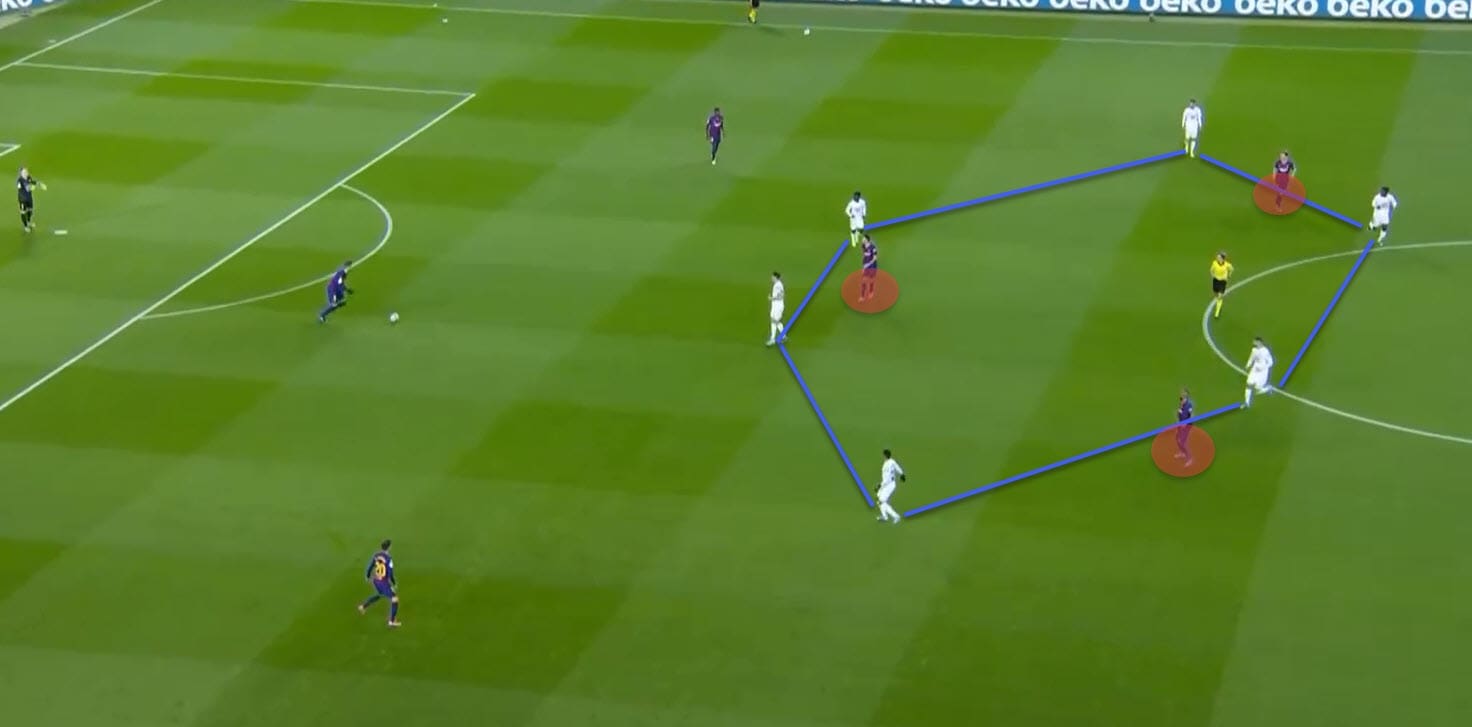
You can see an example of that aspect of their tactics in the image above. But Barcelona couldn’t be contained to that first third of the pitch and Granada’s unwillingness to engage in a high-press often enough gave the Catalans time and space to byass their block and eventually advance up the park.
This would subsequently move Granada’s block, shifting it to a more compact variation of a 4-3-3 or a pure 4-4-2 with, once again, the aim to put Barcelona into numerical inferiority in the middle, restricting their movement and sending them out wide instead.
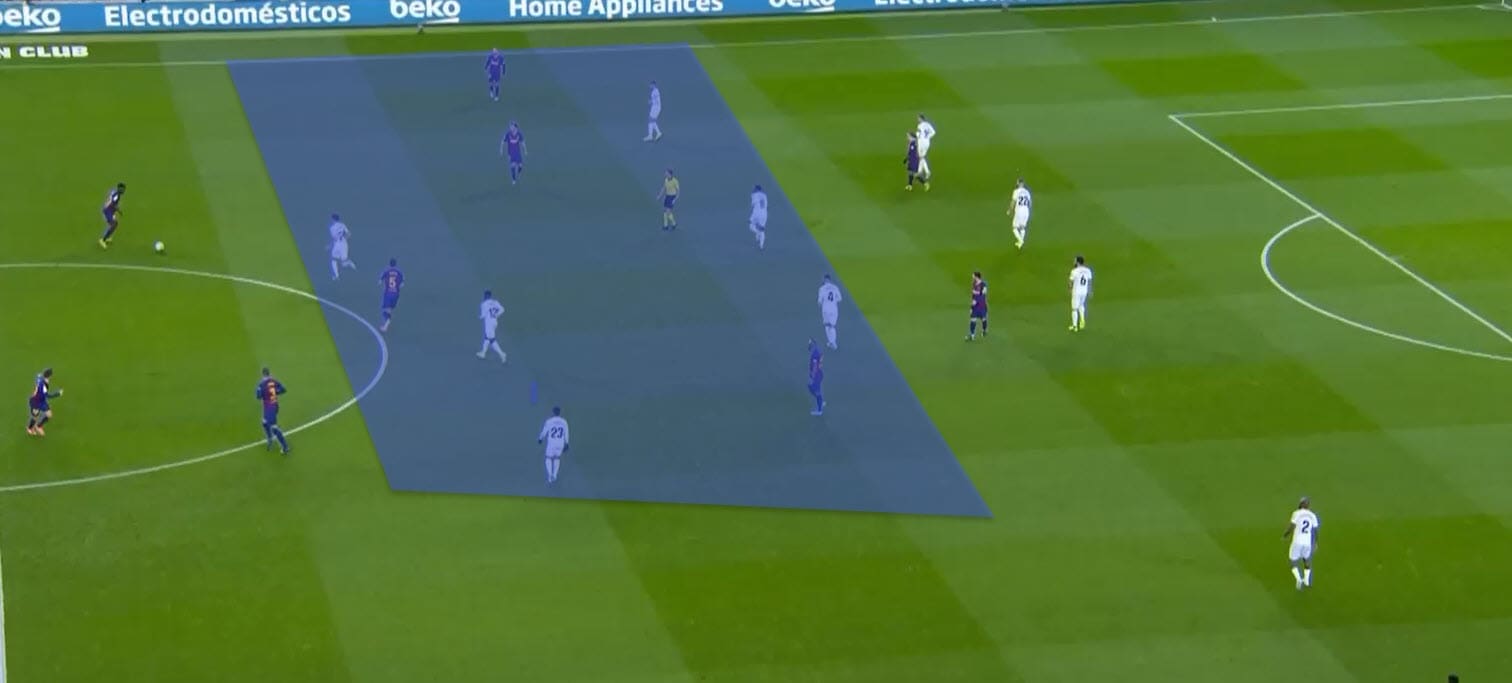
You can see that change in formation and height of their block in the image above. This would go even further and Granada would essentially drop most of their outfield players in and around the zone 14, sometimes playing with five or six players in their backline, ensuring Barcelona can’t achieve superiorities when moving into the box.
This would happen whenever the Catalans managed to breach their initial block and moved into the final third. Obviously, this left the guests with little to none attacking potential and their only chances were created by either capitalising on misplaced passes or lofting the ball into the opposition’s half when trying to bypass Barcelona’s own press.
The idea was to make use of their extremely high defensive line that sometimes even passed the halfway of the pitch. With both Gerard Piqué’s and Samuel Umtiti’s limited pace – especially in the former’s case – there were chances to be exploited by successfully finding their forwards in advantageous positions behind Barcelona’s back.
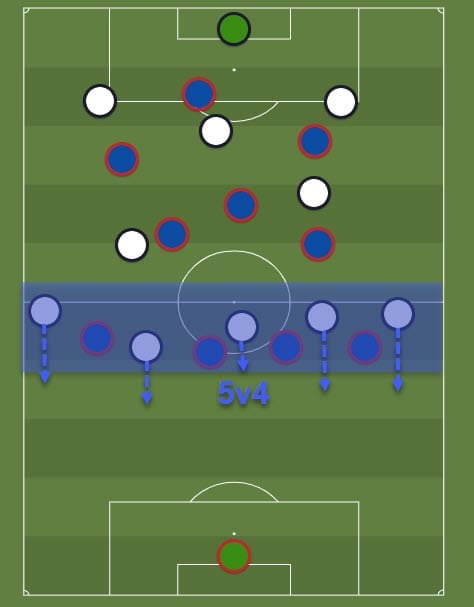
This was really evident when building from the back as Granada often opted to start with a three-man build-up and then push the rest forward, creating a numerical superiority vs Barcelona’s backline and then relying on long balls to reach them, as can be seen above.
Alongside their tendency to scoop up passes and trying to hurt the opposition against the run of play, this was a crucial part of their tactics at the Camp Nou. Unfortunately for them, Barcelona didn’t give them much room to create.
Barcelona’s tweaks to their build-up tactics
As a whole, Setién won’t really revolutionise Barcelona and bring something completely new to their tactics but rather enhance the existing blueprint and maximise its potential. The tweaks he made to their systems were – at least on a largely irrelevant sample of a single game played – minimal but still palpable.
In the gist of it, there were, however, a couple of things to note.
Firstly, Barcelona were building up with a three-man backline that consisted out of the centre-back pairing and one defensive but technical full-back and moved away from the tendency to use their pivot deep in-between the central defenders.
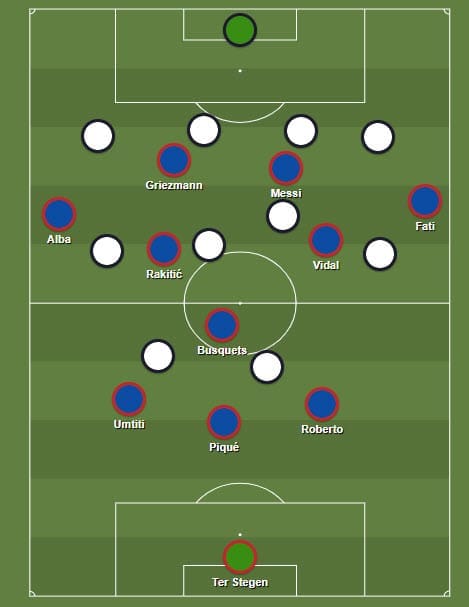
As you can see from the image above, with Granada’s 4-4-2 block in effect, Barcelona can easily outplay their forward line and progress the ball from the first line of defence and into the feet of Busquets. The same can be said for their 4-3-3 iteration that still left them in a 4v3 disparity when pressing the Catalans.
For that reason, they opted against it and decided to box in the midfield, as we have shown in the previous section of this tactical analysis. Of course, with such a setup, channels towards the middle are usually all sealed shut and the attacking team has to opt for a wider approach.
But since Barcelona only had two width providers in the form of Alba and Fati, playing solely through them was not a viable option. Instead, they would still go through the centre and outplay the block with a string of quick, one-touch passes and short distances between the players, allowing them to form triangles to enclose Granada in an endless ‘rondo’ on the pitch.
Still, a crucial part of Setién’s tactics is in the ball-playing centre-backs and that’s why Umtiti got the nod in front of Lenglet in the lineup. The Frenchman was instrumental in finding the midfielders with penetrative passes as both Rakitić (22) and Busquets (18) were in his top three passing links on the night, signalling that he was threading those balls through the compact block of Granada and effectively nullifying their approach.
Another thing this new setup with three at the back did was move Busquets higher up the pitch – instead of his usual in-between the centre-backs positioning – enabling Barcelona to use his vision and penetrative passing to full effect. A usual sequence would then go from the backline to one of Rakitić or Vidal, back to Busquets and then from the Octopus of Badia into the feet of the forwards, mostly and crucially – into the path of Messi.
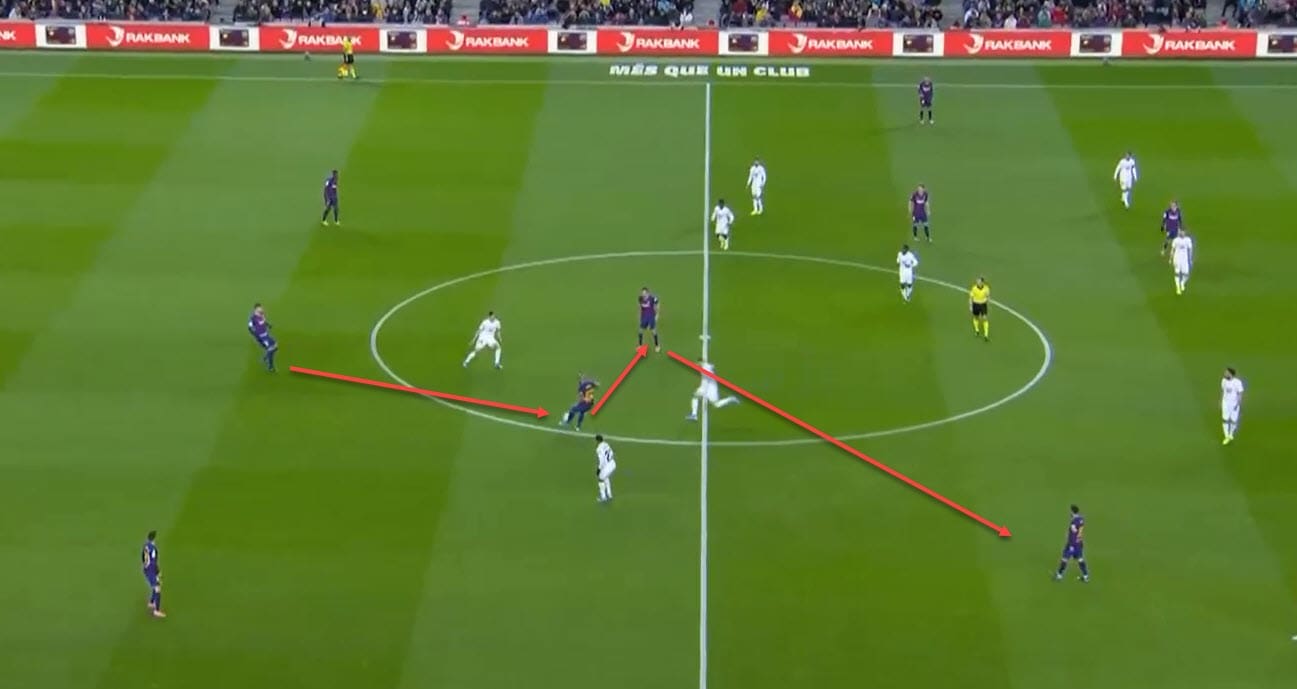
Busquets found the Argentine 30 times on the night, which was Barcelona’s strongest link throughout the game. But the key thing to note here was also Setién’s instructions to Griezmann who was basically all across the pitch – on both flanks, down the centre and deep when needed.
It was actually through him that Barcelona would combat the inferiority in the middle of the park and with him progressing the ball forward or just being utilised as an outlet to eject Alba into space, Messi could stay higher up the pitch and as a result, receive the ball much closer to Granada’s goal.
Notice in the example below how Griezmann moves into a deeper position to form a diamond with Busquets, Rakitić and Umtiti, effectively levelling the playing field for Barcelona to progress the ball forward on a higher platform.
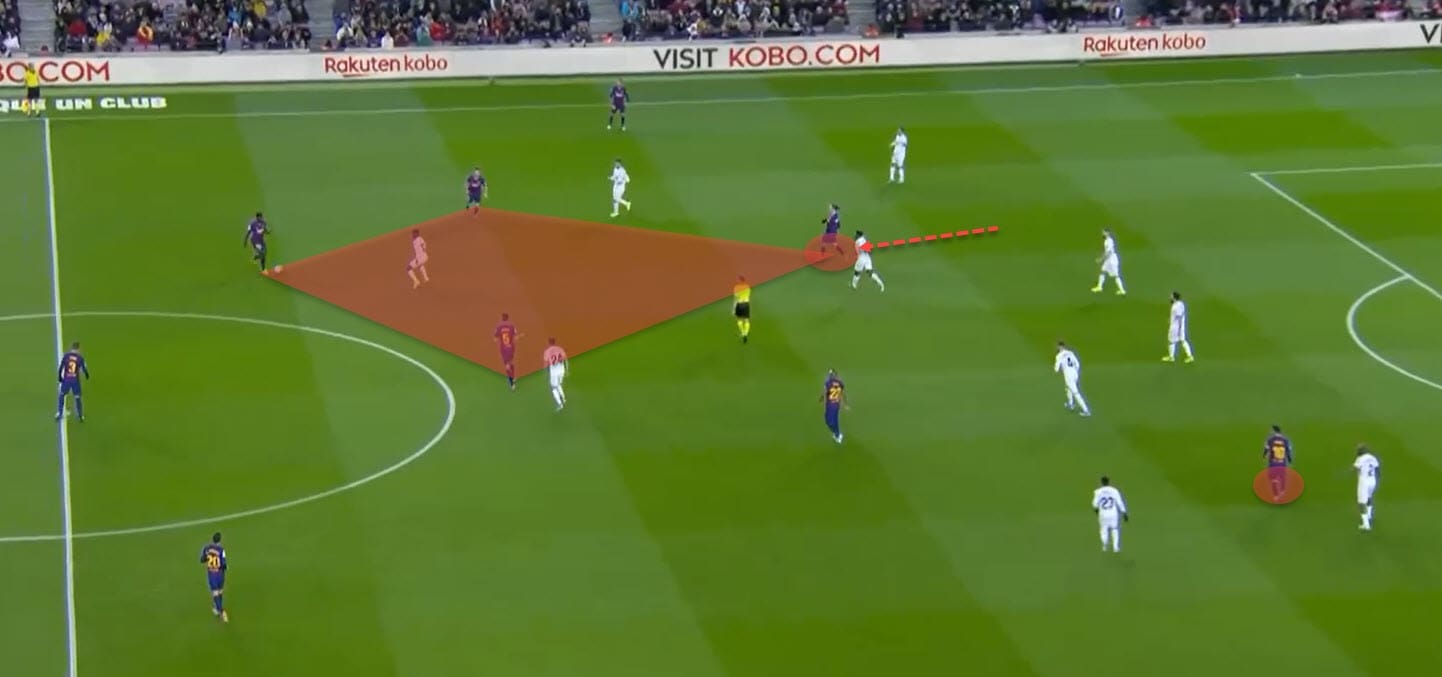
In that particular instance, Umtiti opts to recycle possession towards the right side of the pitch but usually, with Griezmann opening up an extra channel, the ball could be fed to him and then he would immediately eject it to the wings and into Alba’s feet.
Similarly, if Barcelona were pinned down by the touchline, the same thing would happen – Umtiti pushes forward, Busquets and Rakitić present themselves as options as well and Griezmann and Alba drop slightly deeper to establish the superiority.
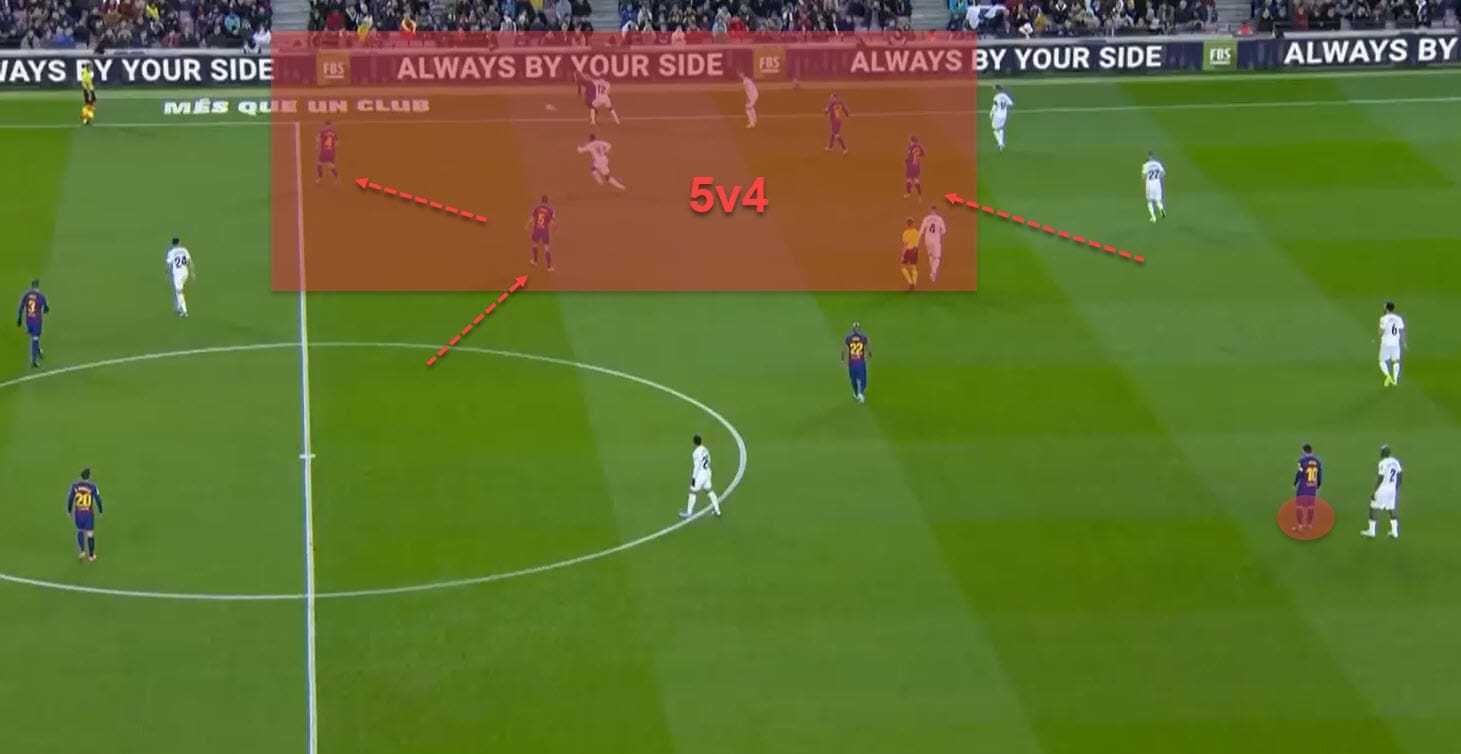
Again – the important thing to note in both examples is Messi’s positioning. With Griezmann doing the dirty work of dropping deep, the Argentine is free to stay high up the pitch instead. Still, with all the shifting and movement manipulation Barcelona have done throughout the game – with various players vacating their positions in order to pull the defensive line apart – they were still struggling with chance creation.
At the end of the day, they could only boast with 1.36 xG as opposed to Granada’s 0.15 despite having an incredible 79% possession and 936 passes on the night. The guest were holding on valiantly and only after they were reduced to 10 men did the shield finally vain and Messi stole the three points away.
The main reason behind their struggle to convert was the absence of a focal, target man in the box. Without Suárez on the pitch, Barcelona were practically without a striker and even though we’ll touch upon the Uruguayan’s absence, which had some clear positives, this was definitely a cutting edge they missed desperately.
Barcelona’s off the ball tactics
One of the main aspects of Setién’s tactics is the high-press he almost exclusively implements at all of his teams. From Las Palmas to Real Betis, the 61-year-old coach thrives on snatching the ball away higher up the pitch and closer to opposition’s goal.
Under Ernesto Valverde, this was not seen as much mostly because the current players in their roster don’t have the legs to continuously press the opposition and expend their energy in that way. For that reason, they would usually sit in a 4-4-2 defensive block with Messi and Suárez devoid of almost any off the ball responsibilities bar cover-shadowing the channels.
Against Granada, however, we’ve seen the high press of Barcelona in full flow and the return of the rapid counter-pressing tactics. Interestingly enough, often it was one of the deepest players, Busquets, who initiated the press while the others marked Granada’s troops man to man, as can be seen in the example below.

So what was different now that it enabled Barcelona to utilise these tactics, yielding them 90 recoveries with 41 happening in the opposition’s half? There are actually two reasons.
Firstly, Suárez’s absence meant they were defending without just one man (Messi) instead of two and secondly, they were instructed to keep short distances between themselves in order to create as many passing lanes as possible but also with an aim to collapse upon losing the ball much quicker and more effectively.
We can see their average positioning in the pass map below.
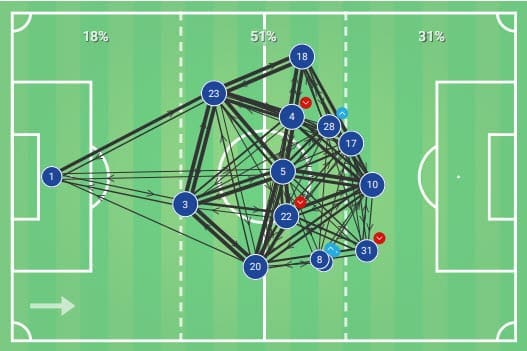
They were extremely aggressive in their approach, as evidenced from their 4.7 passes allowed per defensive action, as opposed to their guests’ 18.6, indicating their contrasting approaches to this game in general.
After all, the only goal of the game arrived after Puig managed to snatch the ball away high in Granada’s half, starting the sequence that led to Messi’s goal in 76th minute of the game.
It will be quite interesting to see how Setién tackles this problem once Suárez is back alongside De Jong and Melo. The former lacks the stamina to go through with such tactics while the Brazilian midfielder can’t replicate Vidal’s energy levels.
But as Barcelona have shown now – it’s also possible to defend by controlling the game, dominating possession and keeping the opposition at bay at all times. This is where Melo and his press-resistance could be key to successfully defend by actually keeping the ball.
Final remarks
It’s far too early to tell how much have Barcelona changed and judging them by a narrow 1-0 victory over Granada at home is not really an effective approach. Their first big test will come against Valencia at the Mestalla and if there are truly big changes on the way, we’ll begin to see them soon.
Still, this victory was marked by possession domination and an effective press deployed by the new coach and his tactics, as was hopefully explained to you by this tactical analysis.





Comments